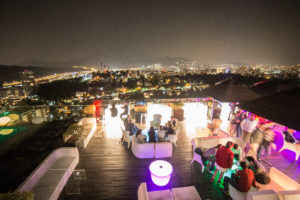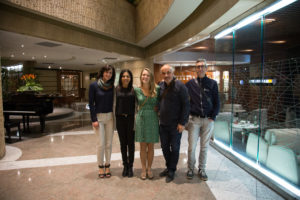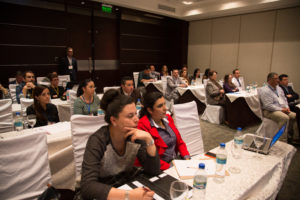Multi-Active Cultures Explained: Bolivia, Chile and Morocco
Multi-active countries represent a culture where relationships are more important than schedules. The usual course of action here would be adapting to situations as they come and paying close attention to the relationships you build on the way.
People from multi-active country can be very expressive and emotional. They lead discussions with passion and get so excited during a conversation that they can even interrupt you!
According to the Richard D. Lewis model, you will find most of the countries leaning towards extroversion in the South. Examples include Africa, Southern Europe, Middle East and South America.
There are multi-active countries that show great potential as emerging markets for international student recruitment. That’s why today we’ll take a look into the most promising top 3.
Bolivia

For many years Bolivia was not even on the map for international student mobility and education. However, lately things have been changing. 2015 data shows that the Bolivian population grows at 1.56% rate. 32.85% of the total population is younger than 14 years old. The majority of people (68.5%) live in urban areas.
Bolivia is a fascinating mixture of influences, languages and backgrounds. It fuses together elements of both Amerindian indigenous and European cultures. It’s also the country with the highest percentage of indigenous people in South America and one of the world’s most biodiverse regions.
With extensive natural resources, rapid economic growth and substantial private investment in education, Bolivia has a great potential to become a key source of international students.
What is important to know about life in Bolivia?
- It can be quite chaotic: Daily life in the densely populated Bolivian cities is often extremely chaotic. This combination of urban jumble and stunning biodiversity brings mostly eco tourists to the country. And while that, as Mark Cramer claims, can mean too many adventures for a foreigner, locals adapt instantly with ease. Their ability to improve and fix pretty much any situation is almost extraordinary!
- It makes you get the most out of everything: The capital city of El Paso sits at the highest altitude in the world, in the heart of the Andean mountains. Surrounded by desert, humid valleys and the Amazon rainforest, this is one of the world’s biggest and most diverse ecosystems. This stunning landscape brings along many issues related to water supply, food security, pollution and natural disasters. Used to being exposed to such constant threats, Bolivians are living for the day. They’re always looking for new opportunities and getting the most out of every situation.
- It makes you cheerful and honest: Beautiful nature together with sometimes harsh historical and economical conditions have formed the typical Bolivian character. Bolivian people are loudly appreciating and being proud of their rich heritage and culture. At the same time, they are also very humble, kind, honest and concerned about their friends and family welfare.
Chile

Chile has reached an advanced stage in terms of demographics. Low fertility and mortality rates and longer life expectancy push it down the way to becoming an aging society. Almost half (43.21%) the Chilean population right now is between 25-54 years of age, and education comprises about 15 years of everyone’s life.
These factors might suggest that conditions are ripe for a market for adult education as well as graduate studies abroad. The majority of the local population have already gained their local college or university degrees and are currently at their top earning age.
Historically, the country has a long tradition of emigration. However, with decreasing poverty, stable economics and the development of democracy, more people from the region (especially Peru) decide to immigrate to the Chile.
Here are some interesting facts about Chilean culture:
- It’s all about relationships: A perfect example of a multi-active culture, Chile group work and group opinion that asserts established norms and consensus within the society. The most productive collaborations in work as well as elsewhere happen when a strong bond between the two parties is established. Friendly and open communication is key.
- Peculiar cultural and political contradictions: While the country’s official language is a local dialect of Spanish, most of the other elements of Chilean culture are quite mixed and sometimes even contradicting each other. For that reason it can be hard to pinpoint the main features of the Chilean national character.
- Quite conservative compared to other South American countries: Godoy’s research back in 1986 explains this historically with the many levels of relationships among the traditional hacienda (local estate manor) members: the landlord and his peasants. Usually, the landlord would take over a paternalistic role, offering not only salary and shelter but also protection. This historical past has resulted in a weak civil society and relationships based on domination both in the public and private sectors that only recently have started to fade out.
- Strong emphasis on fatalism: Chileans have a deep-rooted belief that a person can do very little in order to change things around them. This can also be related to previously mentioned political practice. If most decisions are made single-handedly, the overall situation can be seen as not open to change. Nevertheless, recent democratic movements have been working towards changing this into a more liberal decision-making process.
Morocco
Other Sub-Saharan African countries and their neighbours from the North (Romans, Vandals, Andalusians) have heavy influence on Moroccan culture. Almost everyone in Morocco today considers themselves Muslim. The official spoken language is Arabic, while French is the language of business or formal and international settings.

Traditional handmade leather souvenirs in Essaouira, Morocco
In reaction to pro-democracy protests in 2011, Morocco introduced a reform program that established a new constitution. The changes gave new powers to the prime minister and the parliament.
This was among the first steps towards economic developments and education reforms envisioned for the future. You can already see results today, for example a mega-project that aspires to make the region a leading producer of solar power.
So, what are the characteristics of the Moroccan way of life?
- Take your time: Moroccan people use deadlines in flexible terms. Or they don’t use them altogether. Thus, life for foreigners of linear-active cultures can easily become a nightmare. Everything runs at its own speed. People take time to be with their families, pray or simply enjoy an idle day at the café.
- Honor the family: With the Islamic religion being such a huge influence in the country, concepts of honour and dignity are exceptionally important. Personal and family honour are so important that shame is a reason to ostracise a member or an entire family. Family is the main unit in the Moroccan society, and family welfare is put above any personal comfort. Each member of the family is valuable and has a duty to give back.
- Culture of sharing: Moroccans are active members of the family and the local community, and this applies to all aspects of everyday life. They share meals, contribute to the family budget and work hard to build a better life for everyone in their social circle.
- Personal relationships: Family definitely is the main focus for every Moroccan. However, in order to be able to provide the best they can for it, Moroccans also focus on building strong personal relationships. They don’t do business with someone who is unknown to the family, and family friends will be the first to get a job offer. Naturally, everyone expects to make a favour in return. In this way, Moroccans strengthen their local community.
Are you wondering what cross-cultural management tactics to use with multi-active international students? Watch out for our next post!










































